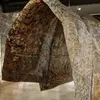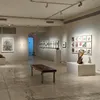Look back in solitude: Exhibits at Kiran Nadar Museum of Art explore the effects of pandemic isolation
The Kiran Nadar Museum of Art (KNMA) in Delhi has opened two on-ground exhibitions of artists Atul Dodiya and K Ramanujam, exploring the effects of isolation
With the COVID-19 pandemic now becoming endemic to our living, artists and art enthusiasts can finally see light at the end of the tunnel. After all, the emotions evoked while viewing a work of art in person can never be replicated digitally.
Kiran Nadar, a well-known art collector and patron of the Indian art community, is the most excited about opening the Kiran Nadar Museum of Art (KNMA) in Delhi to the public after two long years.
“The pandemic was a very tough time but we continued our work virtually. We showed older exhibits and also curated fashion and cooking content for our digital audience. We had a lot of viewership and people were interested in what we were doing. It was a good journey but a tough one, since we were learning as we went along! Thankfully, things are back to normal. We are so happy to be able to meet in person, and we are planning lots of new things at KNMA,” says Kiran in a conversation with YSWeekender.

Artwork of K Ramanujan at Kiran Nadar Museum of Art
Passion for the arts
Kiran’s journey into art began when she started collecting the works of artists like MF Hussain, Rameshwar Broota, and Manjit Bawa for her own home. With a keen eye for talent and a passion to support Indian artists, she painstakingly grew her personal collection of art over the years. The next logical step, therefore, was to share this love of art with the world.
Kiran’s initiatives have shaped and inspired the Indian art world by playing a prominent role in increasing the visibility of Indian modern and contemporary art worldwide. Through her vision, consistent efforts, and unfailing enthusiasm, she has given India a global platform to showcase and promote Indian art – the KNMA, New Delhi.
“My foray into the world of art was the result of a combination of circumstances and factors, including some intuitive judgment, a few adventurous experiments, and experiential learning of the art ecosystem. Over the years, I’ve evolved from a passionate art collector to an astute art lover, and this has strengthened my determination to enrich, enhance and inspire young artists of India and build a museum for generations to cherish the vivid art heritage created by contemporary Indian artists,” she explains.
Kiran’s continuously expanding and diverse art collection today comprises over 8,000 artworks representative of all major phases of modern and contemporary Indian art. This vast collection is showcased in two venues under the KNMA banner, with a combined display area of approximately 50,000 sq ft.

Artwork of K Ramanujan at Kiran Nadar Museum of Art
The museum
Established in 2010, the KNMA is India’s first private art museum. Since its inception, it has housed India’s most talented artists and bridged the gap between art and the public at large through exhibitions, publications, educational, and public programmes. KNMA is a not-for-profit organisation that works on a strictly non-commercial model.
Kiran established KNMA as an exhibition platform to showcase new art forms, in turn, ensuring art’s accessibility to people. Through it, she strived to drive dynamic outreach programmes to nurture a museum-going culture among India’s youth.
The museum has hosted over 100 international exhibitions and art exchange programmes; has counted over 15,000 international visitors from around the world; and participated in extensive collaborations with major educational institutions and organisations like NDMC, NCERT, and FICA to bring art education to diverse audiences.
The museum has organised large-scale exhibitions of the work of globally acclaimed Indian artists such as Nalini Malani, Rameshwar Broota, Subodh Gupta, Nasreen Mohamedi, Raja Ravi Verma, Akbar Padamsee, MF Hussain, FN Souza, SH Raza, Krishen Khanna, Himmat Shah, Ram Kumar, and many others.
“The idea has always been to focus on the country’s art heritage. Hence, I have purchased several august paintings of master artists like Rabindranath Tagore, Raja Ravi Verma, Amrita Sher-Gil amongst others that had left our shores. They are part of the heritage collection at KNMA for our countrymen to see,” she shares.
KNMA has also collaborated with globally renowned museums, including the Museo Nacional Centro de Arte Reina Sofía (Madrid), The Metropolitan Museum of Art (New York), Tate Modern (London), Musée Des Arts Asiatiques (Nice), and Musée Guimet (Paris).
In the run-up to the India Art Fair 2022, KNMA is organising several art programmes, and encourages patrons to stay updated on these through their website and socials.

Artwork of Atul Dodiya at Kiran Nadar Museum of Art
Ongoing exhibitions
After functioning virtually for the larger part of two years, the museum has reopened with two new exhibitions at DLF South Court Mall at Saket, Delhi. These are ‘K Ramanujam: Into The Moonlight Parade…’ and ‘Atul Dodiya: Walking With The Waves’. The preview took place on March 22, 2022 and the exhibitions are open to the public from March 23.
Both exhibits have been curated by Roobina Karode (Chief Curator and Director at KNMA). She says, “I wanted to take us back to the human figure and its recreations through an array of visual stimuli. These two artists are spaced by distinct junctures in Indian art, and yet, connected through underlying chords of hope and resilience, in the face of isolation and solitude.”
K Ramanujam, an artist who resorted to suicide at age 33, before tasting success, has since become known as an exceptional figure of Indian modernism. The exhibit of his works provides the audience with a unique opportunity to view rare drawings and paintings of the artist, including his seminal 13-feet panorama ‘My Dream World’ (made in 1973).
Speaking about the artist, Kiran says, “Ramanujam is perhaps the most enigmatic and underrepresented figure of Indian modernism. He was a member of the largest artist’s commune in India – the Cholamandal Artists’ Village founded in 1966 by painter-pedagogue KCS Panicker. Despite proving himself to be a draughtsman and colourist of exceptional calibre since he was a student of Panicker, Ramanujam found it difficult to find a world sensitive to his congenital anomalies and alleged schizophrenia, which often made him choose the life of an outcast.”
Born with a speech impediment into a conservative Tamil Brahmin/Iyengar family and a middle school dropout, Ramanujam’s inspiration lay in Chandamama (‘Uncle Moon’), a South Indian children’s magazine renowned for its puranic stories and intricate illustrations, as well as Tamil cinema posters and gigantic hoardings that kept him company as he slept on the streets.
Atul Dodiya’s exhibit ‘Walking with the Waves’ consists of recent works created in 2020/21 – 365 water colours for 365 days of the pandemic-induced lockdown. This body of intimate and small-format water colours was a response to the pandemic, when the artist retreated into his inner world, his sanctuary.
“With time at hand while quarantined at home, I began exploring the world outside. My work was therefore rooted in the real, yet silently allowed the fantastic to enter its image-scape,” explains Atul. For these works, he dredged up from the depths of his mind, extemporaneous views of trees, creepers, plants, sky, clouds, water bodies, and waves of imagination.
His collection has been edited to display 270 works from the series. The commonality between the two exhibits lies in their expression of the effects of solitude on the human mind.
Kiran signs off by saying, “The two exhibitions together will reveal intricacies and profundities that solitary creative minds can reach and bring out for the onlooker, by touching upon unforeseen emotions and sensibilities that can only arise from a period of great crisis and subsequent respite through healing.”
Edited by Kanishk Singh









